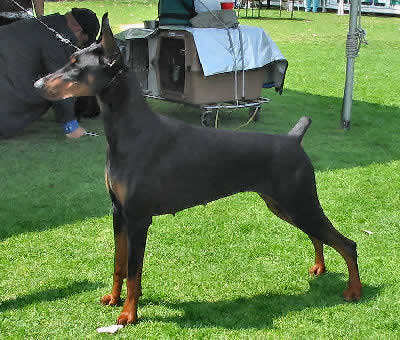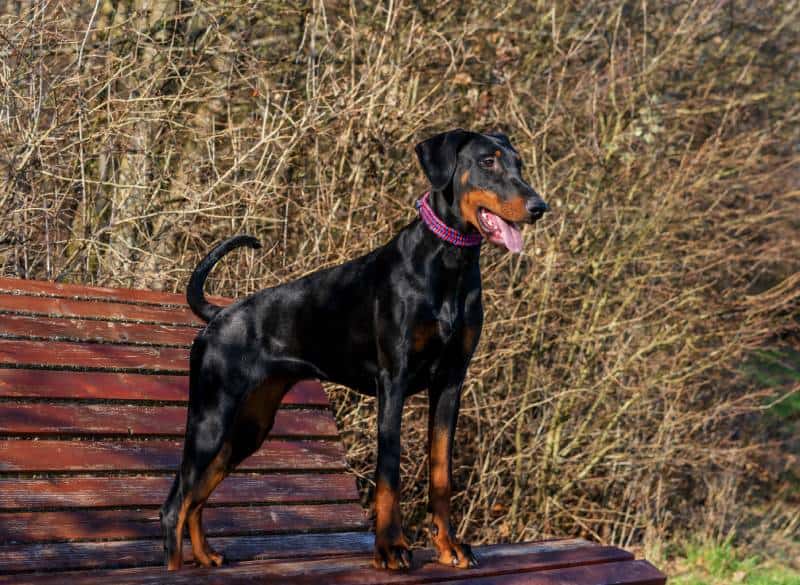
The energetic Doberman is a highly intelligent and active dog breed, and eager to please!
The Doberman Pinscher makes a great guard dog, but it can also be a loyal companion. They enjoy their owners and thrive with human interaction and leadership. With early socialization and a firm but gentle hand in training, they make a wonderful and responsive companion.
The Doberman thrives on attention from humans. They get along well with children, as long as they have been raised with them. As far as other pets go, they will often be aggressive with them and especially with other dogs. They have a short tight fitting coat, so do best kept indoors. But provide yard time and regular activities to give them exercise and and outlet for all that energy.
Doberman Pinschers are medium sized dogs that are compact, muscular and athletic. They are intelligent and have high-energy. Dobies are powerful dogs bred for strength, speed and endurance. They make outstanding watch dogs and guard dogs. But besides being a guard dog, this breed can also be trained for a variety of other purposes.
When choosing a Doberman Pinscher, look for signs of wobbler disease, heart problems, and bleeding disorders. Eye problems and hip dysplasia are also sometimes found in the breed.
- Kingdom: Animalia
- Phylum: Chordata
- Class: Mammalia
- Order: Carnivora
- Family: Canidae
- Genus: Canis
- Species: lupus familiaris
Common Name(s)
Doberman Pinscher, Dobermann, Doberman, Dobie
Breed Type
The Doberman Pinscher is a working breed. Known for being a great guard dog, the Doberman is increasingly sought after as a family dog. This breed is best suited to warm climates.
Background
Doberman Pinschers originated in Germany in the late 1800s. Its ancestry includes a number of breeds, and there is some debate as to which exact breeds were used. Some that are widely agreed upon include the Pinscher, Rottweiler, Greyhound, Great Dane, Weimaraner, and German Shorthaired Pointer. The goal of the Doberman’s breeding was to create a strong, ferocious, yet loyal guard dog and companion.
Description
The Doberman Pinscher is a muscular dog with a short, stiff coat. Colors include black, black and tan, blue-gray, red, and fawn. White Dobermans are also found on occasion, but are not accepted by some clubs. The Doberman’s eyes are dark, and its ears houndlike if not cropped. The tail is very long, but is usually docked where permitted. Males measure 26-28 inches in height, and females 24-26 inches. Weight is 66-88 pounds for both sexes.
Care and Feeding
The Doberman’s diet should include beef, horse meat, corn, and wheat. Dobermans do not require much grooming. They should be brushed and bathed only as needed. Traditionally, Doberman Pinscher puppies’ tails are docked, and their ears cropped and taped to make them stand up. But many countries have outlawed the practices, and many kennel clubs allow the dogs to be shown with or without cropping and docking.
Dobermans need yearly checkups. Vaccinations should be administered on the following schedule:
- 6-8 weeks: Distemper, Leptospirosis, Hepatitis, Parainfluenza, Parvo, and Corona virus (DHLPPC)
- 10-12 weeks: Second DHLPPC
- 14-16 weeks: Third DHLPPC and rabies
- Annually: DHLPPC and rabies booster
Dobies shed moderately. Regular vacuuming is required.
Housing Your Dog
The Doberman should be kept indoors, but needs to get out for exercise each day. It is important to keep this breed warm.
Social Behaviors
Socialization is important for Dobermans, and should be started as early as possible. They do well with children if raised with them. They are often aggressive toward other pets, especially dogs.
Handling and Training
This breed requires firm, consistent training. Although the Doberman can be stubborn, it is highly intelligent and eager to please his owner.
Activities
The Doberman is a high-energy breed, and it needs lots of exercise. It should be taken on a walk or jog each day, and also enjoys intense play sessions.
Breeding/Reproduction
When selecting a mate for your Doberman, it is important to check bloodlines for genetic health problems. Things to look for include Von Willebrand’s disease, heart problems, wobbler disease, eye problems, and cancer.
Common Health Problems
Dobermans are prone to bloat, and should be fed two or three small meals each day instead of one to help prevent it. They may also become overweight as they age, so regular exercise and proper diet are crucial.
Availability
Doberman Pinschers are fairly easy to find. Prices can be anywhere from $400 to $2,000 or more.
References
- Liz Palika, The Howell Book of Dogs: The Definitive Reference to 300 Breeds and Varieties , Howell Book House, 2007
- American Kennel Club, The Complete Dog Book: 20th Edition (Complete Dog Book) , Ballantine Books, 2006
- Doberman Pinscher, Copyright Dog Breed Info Center
- Doberman Pinscher, Wikipedia
- Doberman Pinscher Puppies for Sale, Copyright PuppyFind.com, LLC
Featured Image Credit: Michsa, Shutterstock
